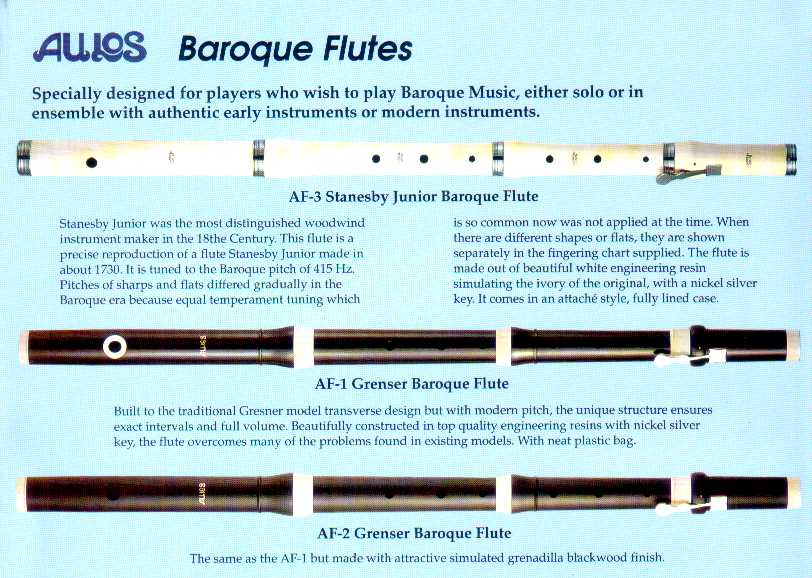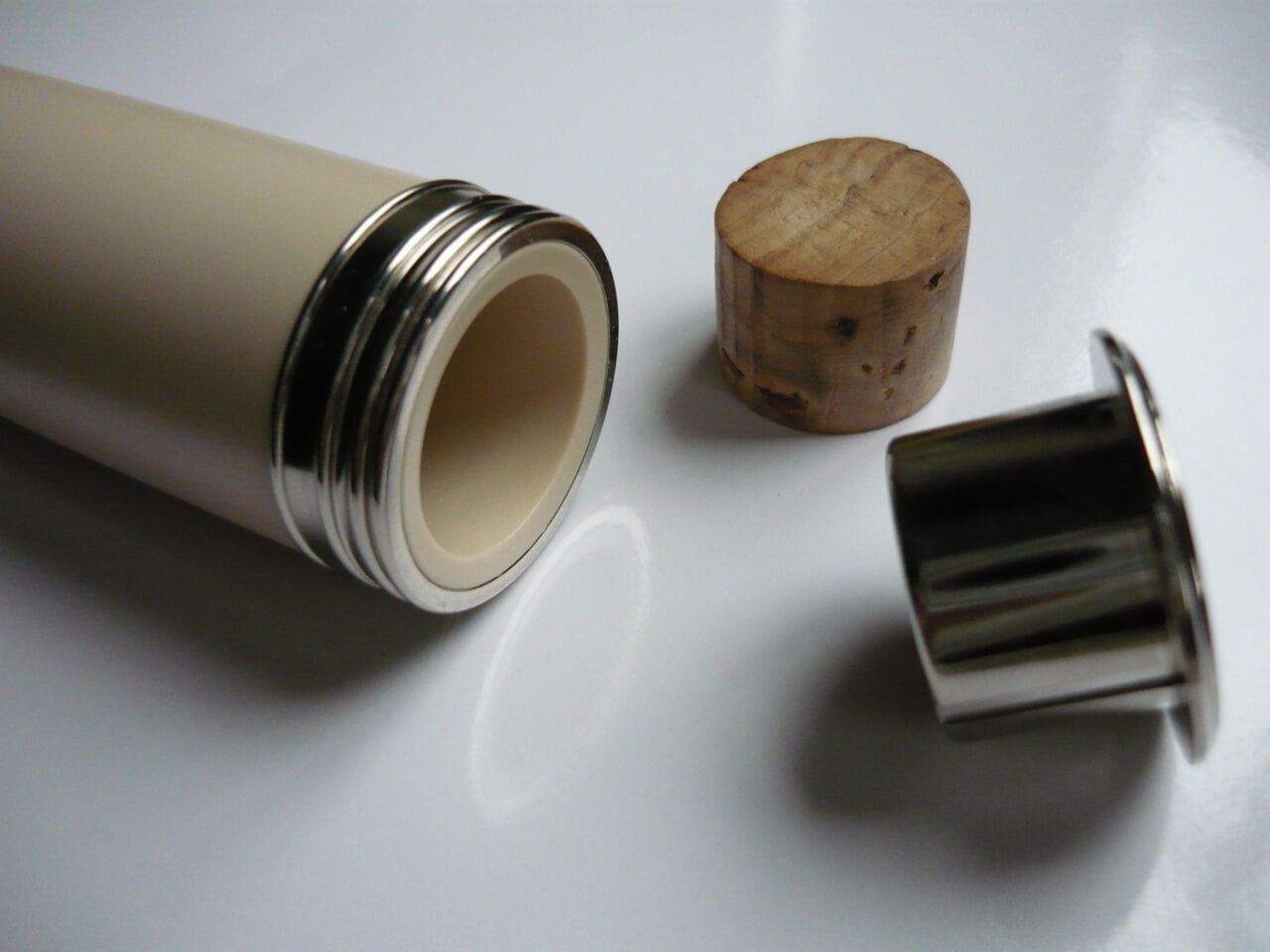Aulos started making the world’s first resin traversos in 1985. And they’re still the only company mass-producing this instrument. There are a few makers of resin traversos now, but they still remain mostly handmade.
Aulos has two models for sale: the AF-1 and the AF-3. They also used to have the AF-2 model with a matte finish to simulate the look of grenadilla. The AF-1 has been redesigned to look like the AF-2, the only difference being the finish. It seems that the Stanesby Jr. also went through some small changes over time, but I couldn’t find much information about it online.

The AF-1 is modelled after flutes by August Grenser, a flute maker from Dresden. It’s pitched at A = 440 Hz. It’s black and has a glossy finish — like plastic recorders — giving it a cheap look. The mounts (the white parts) in particular aren’t good looking.
Despite the looks, the instrument is well made. The joints aren’t loose and they fit well together. It has a screw-cork, so it’s easy to adjust the tuning. The cork is a stopper made of metal. Even with regular cleaning, it’s starting to show some signs of oxidation. The key is made of nickel silver and has a leaf-spring mechanism, with a faux-leather padding.
To adjust the tuning, turn the endcap on the headjoint clockwise to pull out the cork. The endcap will start coming out when going anti-clockwise. Push it back in and the cork will move along with it.
The embouchure hole on the Grenser is more modern than on other baroque flutes. It’s larger and has an elliptical shape, giving the instrument a louder sound. By adjusting your technique, you can get a dark reedy tone on its lower notes, or you can play very delicately. It also makes the instrument a little easier to play.
Here’s a video showing how the AF-1 sounds:
The AF-3 is a reproduction of an ivory flute made by Stanesby Junior around 1730. It’s pitched at A = 415 Hz. It feels really good in the hands. The endcap and the mounts are made of chrome. I’d say it has a premium feel to it. The instrument is as well-built as the Grenser, design differences aside. But the endcap on the headjoint doesn’t have a screw-cork. There’s a real cork inside the headjoint.
To tune this flute, you have to use a wooden dowel to push the cork out. To push the cork closer to the embouchure hole you have to push it all the way out and remove the endcap first. While I’ve never tried it myself, this instrument is tunable. There’s a paper that comes with it talking about tuning. It also says though the cork is not glued, it is tightly set
, so Aulos must get a lot of questions about this. There’s a thread on Chiff & Fipple about removing the endcap of the Aulos AF-3. A user (Uke) sent Aulos an email and got the following reply (paraphrased):
The Aulos AF-3 is only made with the same endcap as the original Stanesby Jr. flute. This flute didn’t have a screw-cork for tuning the pitch.
You can remove the cork and endcap from the headjoint by using a wooden dowel of the same diameter as the cork. You have to hit the dowel lightly with a wooden hammer to push the cork little by little.
The chrome endcap was fixed tight (not glued).
In the same thread, another user (Skap) managed to remove the cap and posted a photo. According to him, while dislocating the cork from its position was relatively easy, the cap itself sat insanely tight... The stopper is a natural whole cork, quite fragile and fragilized even more by humidity... The metal cap is quite heavy
. It’s interesting to see that the endcap and the ring at the end of the headjoint are two separate pieces. Now I know why trying to pull on the ring to remove the endcap doesn’t work, and where people’s confusion must come from.

Putting the tuning aside for a moment... The Stanesby Jr. has a quieter, more delicate sound, but it still has a good dynamic range. It blends well with other period instruments. The embouchure hole of this instrument is smaller and has a circular shape, like the original instrument and other flutes from the same period. You need better technique to play well.
If you want to hear how it sounds when compared to professional flutes, check these videos:
Both the AF-1 and AF-3 come in a soft vinyl bag with joint grease, a cleaning rod, a cleaning cloth, and the manual. The Stanesby Jr. was sold only with a hard case, but now Aulos sells this model with a soft case as well. The hard case adds to the premium feel of the instrument, but the case itself is pretty standard quality.
For both instruments, the only criticism I have is that they are quite heavy. The AF-3 being the heaviest. I’m not a fan of the glossy look of the Grenser too. You can find people complaining about quality issues online — like the Grenser not fitting well, or the Stanesby’s key having problems — but it seems Aulos solved those over time. I haven’t had any problems with them.
Another common complaint I’ve seen is that these instruments have tuning issues. Some people even sell fixed versions of them. See for example, Roderick Cameron or the Antique Sound Workshop pages. Here’s a quote from the Antique Sound Workshop page about the tuning defects:
These excellent reproductions exhibit the same intonational problems as the museum originals, specifically sharpness on a number of notes in the second octave due to dehydration and shrinkage over several centuries. However, our instruments also include custom tuning and voicing in our workshop, which nicely corrects the intonational problems.
Whether they have tuning problems or not, that’s up for debate. Every baroque flute I’ve played required some adjustment when playing. I either had to adjust for a few notes, or change my whole playing style. Besides the variation between individual instruments, the traverso was never supposed to play in modern temperament. That’s just how those instruments are. Trying to fix them is a disservice to the player.
Do I recommend those instruments? Sure, even as a spare for practice if you already have another flute. Being made of resin has its advantages. Resin flutes aren’t sensitive to temperature and humidity like wooden flutes, and they need less maintenance. They don’t have a breaking in period, and you can play them as long as you have breath left.
As another option at around the same price of the Stanesby, you could get a Bernolin traverso. Under a $1000 USD you could also get a Luca Ripanti flute made of resin. Both makers have a waiting list, so if you’re in a hurry go for the Aulos.
There are other alternatives if you’re willing to dive into the realm of 3D printing. There’s a 3D printed traverso by Jomalier Figueroa with the flute available for download. There are 3D printed flutes by Jeff Wulf which costs under $300 USD (Tortochot & Naust demonstration). There’s the 3D Early Winds project. And there’s research at the Paris’s Cité de la Musique laboratory about 3D printing baroque flutes.
Just try to avoid wooden flutes around the same price range. They’re not well made and they’re a waste of money. And avoid buying an Irish flute thinking it’s going to work as a baroque flute. It won’t. They’re different instruments. Please, do your research before buying any instrument.